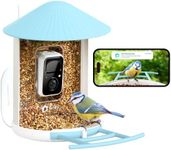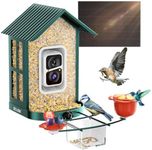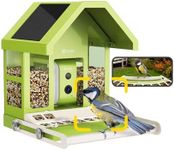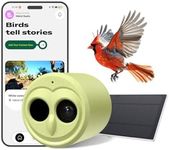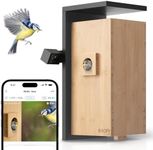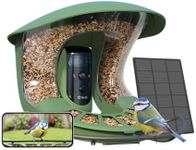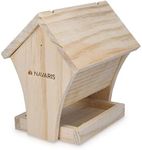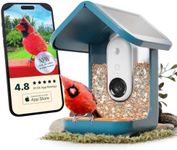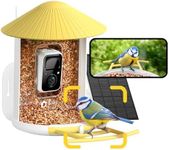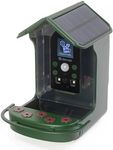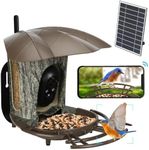Buying Guide for the Best Bird Feeder Cameras
Choosing the right bird feeder camera can greatly enhance your bird-watching experience by allowing you to capture and observe birds up close without disturbing them. When selecting a bird feeder camera, it's important to consider several key specifications to ensure you get the best fit for your needs. Understanding these specs will help you make an informed decision and enjoy the best possible bird-watching experience.ResolutionResolution refers to the clarity and detail of the images or videos captured by the camera. Higher resolution means more detailed and clearer images. Common resolutions include 720p (HD), 1080p (Full HD), and 4K (Ultra HD). If you want to capture fine details of the birds, such as feather patterns, a higher resolution like 1080p or 4K is recommended. For general bird-watching, 720p may suffice. Consider your need for detail and storage capacity, as higher resolution videos take up more space.
Field of ViewField of view (FOV) is the extent of the observable area the camera can capture. A wider FOV allows you to see more of the surroundings, which can be useful if you want to monitor a larger area around the feeder. FOV is usually measured in degrees. A narrow FOV (less than 90 degrees) focuses on a specific area, while a wide FOV (90 degrees or more) captures a broader scene. Choose a FOV based on whether you want to focus on the feeder itself or include more of the surrounding environment.
Night VisionNight vision capability allows the camera to capture clear images and videos in low light or complete darkness. This is important if you want to observe nocturnal birds or capture footage during early morning or late evening hours. Night vision is typically achieved through infrared (IR) LEDs. Cameras with good night vision will have a higher number of IR LEDs and a longer range. If you plan to monitor birds at night, ensure the camera has strong night vision capabilities.
ConnectivityConnectivity refers to how the camera transmits the captured footage to your viewing device. Common options include Wi-Fi, Bluetooth, and wired connections. Wi-Fi-enabled cameras allow you to view live footage remotely on your smartphone or computer, which is convenient for real-time monitoring. Bluetooth is useful for short-range connections, while wired connections provide a stable and reliable link. Choose a connectivity option based on your preference for remote viewing and the setup of your bird feeder.
Power SourceThe power source of the camera determines how it is powered. Options include battery-operated, solar-powered, and plug-in cameras. Battery-operated cameras offer flexibility in placement but require regular battery changes or recharging. Solar-powered cameras are eco-friendly and reduce the need for frequent maintenance, but they depend on sunlight. Plug-in cameras provide continuous power but require a nearby power outlet. Consider the location of your bird feeder and the convenience of maintaining the power source when making your choice.
StorageStorage refers to how the camera saves the captured footage. Options include local storage (SD cards) and cloud storage. Local storage is convenient and provides immediate access to footage, but it has limited capacity and can be lost or damaged. Cloud storage offers more space and remote access to footage, but it may require a subscription fee. Choose a storage option based on your preference for accessibility, capacity, and security of the footage.
DurabilityDurability is the camera's ability to withstand various weather conditions and outdoor elements. Look for cameras that are weatherproof or waterproof, with a high IP (Ingress Protection) rating, which indicates resistance to dust and water. Durable cameras are essential for long-term outdoor use, especially in areas with harsh weather. Ensure the camera can handle the environmental conditions of your location to avoid frequent replacements or repairs.
